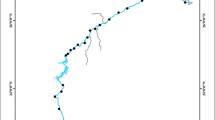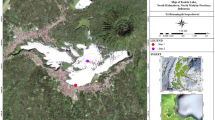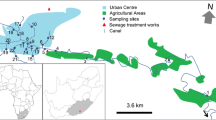Abstract
Biological and chemical data were processed to estimate trophic stage and degree of pollution in several streams and rivers in southern Poland. The majority were eutrophic and some of them heavily polluted; only a few were oligo-mesotrophic. The differences in the water quality of the rivers were reflected by different types of diatom community and also by the values for some diatom indices, which were calculated using the latest version of the 'Omnidia' database software. Except for the Sládeček's index, all diatom indices correlated significantly with organic load (COD), oxygen concentration, conductivity and most of the measured ions. Some indices showed a significant negative correlation with trophic level (expressed by NH4-N and PO4-P). In general, IPS (Specific Pollution Sensitivity Index) and GDI (Generic Diatom Index) indices gave the best results. Among the investigated diatom communities, only a few taxa indicated oligo-mesotrophy and oligo-β-mesosaprobity. Most of the sites were characterised by a greater relative contribution of eutraphent and tolerant ones as well as α-mesosaprobic and polysaprobic diatoms. This study suggests that the structure of benthic diatom communities and diatom indices, especially GDI, can be applied for monitoring rivers in Poland.
Similar content being viewed by others
References
American Public Health Association (1992) Standard Methods for the Examination of Water and Waste Water, 18th edition. American Public Health Association, Washington, DC. 1000 pp.
CEMAGREF (1982) Etude des méthodes biologiques quantitatives d'appréciation de la qualité des eaux. Rapport Division Qualité des Eaux Lyon – Agence financière de Bassin Rhône – Méditerranée – Corse, Pierre-Bénite, 218 pp.
Coste M, Ayphassorho H (1991) Étude de la qualité des eaux du Bassin Artois-Picardie à l'aide des communautés de diatomées benthiques (Application des indices diatomiques). Raport Cemagref. Bordeaux – Agence de l'Eau Artois-Picardie, Douai, 277 pp.
Descy JP (1979) A new approach to water quality estimation using diatoms. Nova Hedwigia 64: 305–323.
Descy JP, Coste M (1991) A test of methods for assessing water quality based on diatoms. Verh. int. Ver. Limnol. 24: 2112–2116.
Eloranta P (1995) Type and quality of river waters in central Finland described using diatom indices. In Marino D, Montresor M (eds), 13th Internatational Diatom Symposium, 1994. Acquafredda di Maratea, Italy, 271–280.
Eloranta P, Andersson K (1998) Diatom indices in water quality monitoring of some South-Finnish rivers. Verh. int. Ver. Limnol. 26
Hermanowicz W, Dozanska W, Dojlido J, Koziorowski B (1976) Fizyko-chemiczne badanie wody i scieków [Physico-chemical analysis of water and wastewater]. Arkady, Warsaw, 847 pp.
Hofmann G (1994) Aufwuchs-Diatomeen in Seen und ihre Eignung als Indikatoren der Trophie. Bibliotheca Diatomologica 30, Cramer, Berlin, 241 pp.
Hofmann G (1996) Recent developments in the use of benthic diatoms for monitoring eutrophication and organic pollution in Germany and Austria. In Whitton BA, Rott E (eds), Use of Algae for Monitoring Rivers II. Institut für Botanik, Universität Innsbruck: 73–77.
Kawecka B (1980) Sessile algae in European mountain streams. 1. The ecological characteristics of communities. Acta Hydrobiol. 22: 361–420.
Kawecka B, Kwandrans J, Szyjkowski A (1996) Use of algae for monitoring rivers in Poland. In Whitton BA, Rott E (eds), Use of Algae for Monitoring Rivers II. Institut für Botanik, Universität Innsbruck: 137–141.
Kelly MG (1998) Use of the trophic diatom index to monitor eutrophication in rivers. Water Research 32: 236–242.
Kelly MG, Penny CJ, Whitton BA (1995) Comparative performance of benthic diatom indices used to assess river water quality. Hydrobiologia 302: 179–188.
Kelly MG, Whitton BA (1995) The Trophic Diatom Index: a new index for monitoring eutrophication in rivers. J. appl. Phycol. 7: 433–444.
Krammer K, Lange-Bertalot H (1986–1991) Bacillariophyceae. Süßwasserflora von Mitteleuropa 2 (1–4). G. Fischer, Jena.
Leclercq L, Maquet B (1987) Deux nouveaux indices chimique et diatomique de qualité d'eau courante. Application au Samson et à ses affluents (bassin de la Meuse belge). Comparaison avec d'autres indices chimiques, biocènotiques et diatomiques. Institut Royal des Sciences Naturelles de Belgique, document de travail 28: 113 pp.
Lecointe C, Coste M, Prygiel J (1993) 'OMNIDIA': A software for taxonomy, calculation of diatom indices and inventories management. Hydrobiologia 269/270: 509–513.
Lenoir A, Coste M (1996) Development of a practical diatom index of overall water quality applicable to the French National Water Board network. In Whitton BA, Rott E (eds), Use of Algae for Monitoring Rivers II. Institut für Botanik. Universität Innsbruck: 29–43.
Prygiel J, Coste M (1993) The assessment of water quality in the Artois-Picardie water basin (France) by the use of diatom indices. Hydrobiologia 269/270: 343–349.
Schiefele S, Schreiner C (1991) Use of diatoms for monitoring nutrient enrichment acidification and impact salts in rivers in Germany and Austria. In Whitton BA, Rott E, Friedrich G (eds), Use of Algae for Monitoring Rivers. Institut für Botanik, Universität Innsbruck: 103–110.
Sládeček V (1986) Diatoms as indicators of organic pollution. Acta Hydrochimica et Hydrobiol. 14: 555–566.
Starmach K (1969) Hildenbrandtia rivularis and associating it algae in the stream Cedronka near Wejherowo (Gdańsk voivode). Fragm. Flor. et Geobot. 15: 387.
Steinberg C, Schiefele S (1988) Biological indication of trophy and pollution of running waters. Z. Wasser-Abwasser-Forsch. 21: 227–234.
Whitton BA, Rott E, Friedrich G (eds) (1991) Use of Algae for Monitoring Rivers. Institut für Botanik, Universität Innsbruck, 193 pp.
Whitton BA, Rott E (eds) (1996) Use of Algae for Monitoring Rivers II. Institut für Botanik, Universität Innsbruck, 196 pp.
Author information
Authors and Affiliations
Rights and permissions
About this article
Cite this article
Kwandrans, J., Eloranta, P., Kawecka, B. et al. Use of benthic diatom communities to evaluate water quality in rivers of southern Poland. Journal of Applied Phycology 10, 193–201 (1998). https://doi.org/10.1023/A:1008087114256
Issue Date:
DOI: https://doi.org/10.1023/A:1008087114256




